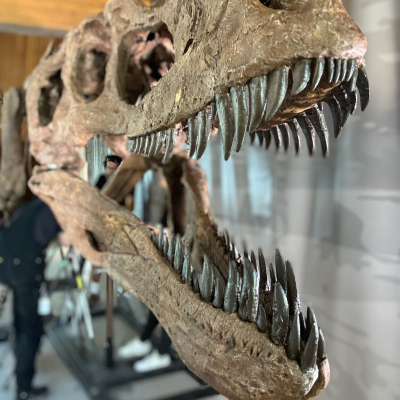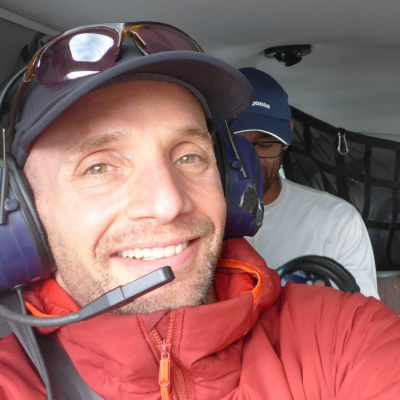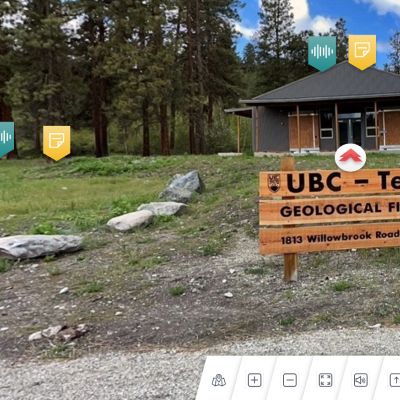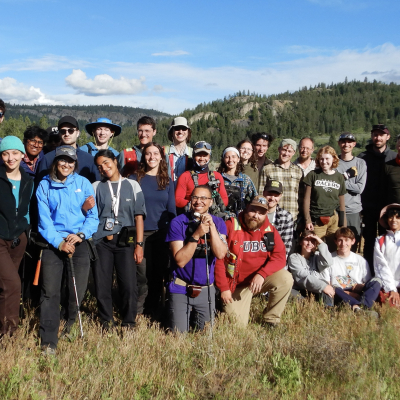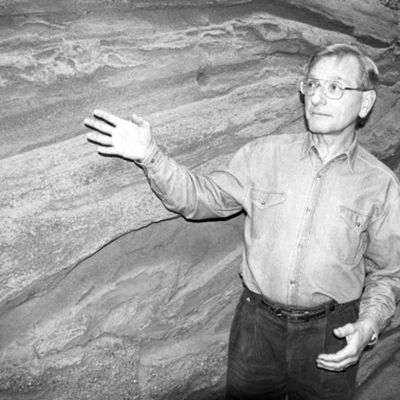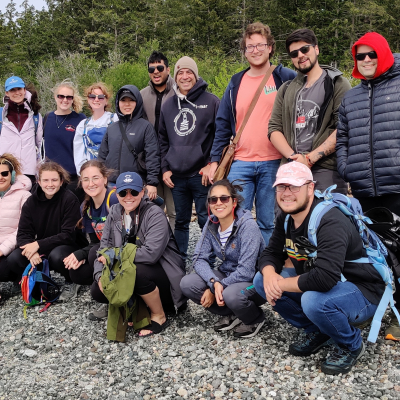News
Stay up-to-date with what's happening in EOAS
Life at the Edge - The Pacific Museum of Earth's newest permanent exhibit
Scenes from the Late Cretaceous, the era of the dinosaurs, have come back to life within the Wheaton Precious Metals Atrium of the Earth Sciences Building (ESB) on the University of British Columbia campus. The new exhibit, Life at the Edge, curated by the Pacific Museum of Earth takes visitors back 75 million years to life at the edge of Earth’s fifth and most recent mass extinction event. Visitors to ESB can see a Daspletosaurus, an ancestor of the iconic T-Rex, chasing down a smaller carnivorous raptor, the Dromaeosaurus.
The exhibit has been designed to provoke thoughts on the precarious, yet resilient nature of life on Earth. Similar to the dinosaurs of the Late Cretaceous, we now face rapid climate change that many predict will bring us to the edge of the 6th mass extinction event. While the exhibit draws parallels between the current Anthropocene and Late Cretaceous, it also highlights important differences. The 5th mass extinction event at the end of the Late Cretaceous was initiated by unstoppable natural disasters. Whereas current increasing extinction rates are due to anthropogenic carbon emissions, land use change like deforestation, and resource extraction. While we may not be able to prevent all the consequences of climate change, we still have the power to adjust our activities to minimize consequences and adapt to change. The exhibit curators hope by highlighting these differences, visitors will feel empowered to initiate conversations within their own communities and take actions where they can.
The exhibit will open to the public on July 2. In the meantime, children at the University of British Columbia’s daycare program had an exclusive sneak peek of the dinosaurs as fossil articulators assembled the fossil casts. Their visit was covered by Vancouver CTV News. Several other media outlets have been quick to cover the new exhibit that hosts the first and only tyrannosaur on UBC’s campus. See below for a full list of Life on the Edge media coverage. Huge thanks to Wheaton Precious Metals whose generous gift made this new exhibit come to life.
Media coverage:
1. CTV News
2. CTV News Vancouver (9:50 mark)
3. Glacier Media via Vancouver is Awesome, Burnaby Now, Richmond News, Tri-City News, New Westminster Record, North Shore News, Squamish Chief, Delta Optimist, Times Colonist, Coast Reporter
4. Vancouver Sun via MSN
Mark Jellinek receives the 2024 Konrad Adenauer Research Award
Congratulations to Prof. Mark Jellinek, who has been honored with the 2024 Konrad Adenauer Research Award by the Alexander von Humboldt Foundation. Professor Jellinek, an EOAS geophysicist, is recognized for his pioneering work on magmatic and volcanic processes, climate change, and geodynamics. This prestigious award celebrates his significant contributions to Earth system science and his efforts in strengthening academic and cultural ties between Canada and Germany. During the tenure of the Konrad Adenauer Research Award, Prof Jellinek will collaborate with Eberhard Bodenschatz, physicist and director of the Max Planck Institute for Dynamics and Self-Organization. Each year the award, valued at 60,000 euros, is given to one internationally recognized Canadian researcher. Congratulations again to Prof. Mark Jellinek for receiving this year’s award.
Takes a virtual tour through the field station!
Check out our virtual tour (https://app.lapentor.com/sphere/teck) through the UBC – Teck Geological Field Station near the town of Oliver in the Okanagan Valley in British Columbia, Canada!
The virtual tour was created by Cynthia Liu in 2022, who was an undergraduate student at the time. It was funded by the Skylight Development Grant (including EOAS matching funds) and the Earth Science Experiential and Indigenous Learning Initiative (EaSEIL) supported by the UBC Teaching and Learning Enhancement Fund and EOAS Department Funds.
Dr. Laura Lukes (Assistant Professor at EOAS; Project lead & manager, research and evaluation of the EaSEIL project) believes that the virtual tour provides students with an opportunity to tour the field station virtually and helps them prepare for learning by reducing the uncertainty associated with going to a new environment. By knowing what washroom facilities, sleeping accommodations, etc. will be like, stress levels can be reduced and the students can focus their attention and energy on learning the content.
The virtual tour has been used by instructors of several courses, including EOSC328, GEOS309, and CONS451, to help students prepare for field course experiences that involve staying at the field station.
“The virtual tour of the UBC – Teck Geological Field Station plays an important role in preparing our students for what to expect during the course. The field station is their “home” for three weeks and the virtual tour allows the students to remotely inspect every aspect of the field station, from their Weatherhaven shelters where they sleep to the washroom/shower facilities, to the main building where they work and eat, to the kitchen area, and also the general environment outdoors. We look forward to using the virtual tour each year going ahead.” –Dr. James Scoates, Professor, Department of Earth, Ocean and Atmospheric Sciences, Instructor for EOSC328
“The field station is the shared home for students and instructors for up to three weeks for EOSC 328 Field Geology. The virtual tour is a great introduction to the space in which students and instructors will be living and working. I have used the virtual tour to introduce students to the field station before they arrive on site. With the camp now in regular operation, I anticipate that the tour will be used and appreciated by both UBC and external users. I am extremely grateful to the EaSEIL team for putting together this much-needed resource and for TELF and Skylight for funding this work among other projects that EaSEIL is undertaking.” –Dr. Joel Saylor, Associate Professor, Department of Earth, Ocean and Atmospheric Sciences, Instructor for EOSC328
“The field station VR is a really nice, simply designed closer-look at the field station. It has been really helpful in my own course for preparing students in advance for their living facilities and the field station environment, orienting students to the place. Nifty pop-up tips on accessibility features, and even how to approach or prepare for a day’s outing, were a plus.” –Dr. Nina Hewitt, Associate Professor of Teaching, Department of Geography at UBC, Instructor for GEOS309
“I really appreciated having the virtual tour available for our students. We view the tour together in class the week before the trip, and they enjoy seeing where they’ll be staying. They have a lot to prepare before embarking on a field trip, and knowing exactly what to expect at the station allows them to plan accordingly.” –Dr. Nolan Bett, Lecturer, Department of Forest and Conservation Sciences at UBC, Instructor for CONS 451
“It’s an absolute pleasure to see the UBC Teck Geological Field Station documented by this virtual tour. It captures the beauty of the area while providing a useful orientation to this professional and well-equipped field station, including notes on what to expect during field school. All that’s missing is the native plant garden in the front, the resident quails, and the amazing students, staff, and faculty that help make these field schools safe, supportive, and unforgettable experiences.” –Dr. Warren Cardinal-McTeague, Assistant Professor, Department of Forest and Conservation Sciences at UBC, Instructor for CONS 451
Okanagan Geology Field School: Three Weeks of Successful Mapping


Imaging the Canadian interior: The legacy of Ron Clowes
Meet Professor Emeritus Ronald M. Clowes, a world-renowned geophysicist int UBC’s Department of Earth, Ocean and Atmospheric Sciences since 1970! During his nearly 55 years as a decorated teacher, mentor, and world-class researcher, Professor Clowes led a remarkable career studying seismology. As one of the leading developers and later director of Canada’s LITHOPROBE program, Prof. Clowes was appointed a Member of the Order of Canada in 1998, one of the nation's highest honors of merit.
Impact on Canadian geoscience
In 1987, Dr. Clowes became the Director of Lithoprobe, a pioneering national geoscience research project focused on imaging the crust and upper mantle. Under his leadership, Lithoprobe became a flagship program that significantly advanced our understanding of Canada's geological framework through extensive seismic and geophysical studies. This program set a benchmark for international geoscientific research collaborations and methodologies. Today, LITHOPROBE research has published more than 1500 research articles. Contemporary geophysical research relies on the methods and data analysis framework developed by the program.
Research focus and contributions
Prof. Clowes' research focuses on seismic and geophysical investigations of the Earth's lithosphere on land and under the sea. His work has provided critical insights into the relationship between seismic data, geological structures, and tectonic processes. These contributions have not only enriched scientific knowledge but also informed practical applications in resource exploration and environmental management.
Distinguished awards and honors
Prof. Clowes' work has been recognized through numerous prestigious awards. In 2005, he received the Logan Medal, the Geological Association of Canada's highest honor. His other accolades include:
-
Canada Council Killam Research Fellowship (2004–2006)
-
Queen Elizabeth II Golden Jubilee Medal (2002)
-
J. Tuzo Wilson Medal, Canadian Geophysical Union (1998)
-
Distinguished Lecturer Award, The Canadian Institute of Mining, Metallurgy and Petroleum (1997)
-
Honorary Member, Canadian Society of Exploration Geophysicists (1995)
-
Fellow, Royal Society of Canada (1994)
-
George P. Woollard Award, Geological Society of America (1993)
-
Past President’s Medal, Geological Association of Canada (1988)
Additionally, Prof. Clowes has been honored with the Distinguished Fellow title by the Geological Association of Canada and has received multiple Best Paper Awards from the Canadian Society of Exploration Geophysicists and Geophysics journal.
Legacy and ongoing influence
Though now an emeritus professor, Dr. Clowes continues to be active at UBC through his teaching and ongoing research. His work has left an indelible mark on geophysics, with his methodologies and findings continuing to influence contemporary studies and technological advancements.
Third annual PRODIGY field school takes place on Vancouver Island
This week students returned from the third annual PRODIGY (Pacific Rim Ocean Data Information and Technology) field school. The international and interdisciplinary group included seismologists, biological, physical, and chemical oceanographers from Canadian universities, the University of British Columbia and University of Victoria, as well as Chilean institutions, Universidad de Los Lagos, Huinay Scientific Centre, and the Universidad de Concepcion.
This program offers a unique opportunity for collaboration between early career western Canadian and Chilean researchers. Despite the great distance between the two countries, they face remarkably similar ocean-related challenges. Both have large growing aquaculture industries, are located on subduction zones prone to tsunami and earthquakes, have extensive and complex coastlines with numerous islands and fjords, and both are documenting extreme low oxygen events in deeper waters. PRODIGY aims to train the incoming generation of ocean scientists to be equipped to address research questions related to these environmental challenges. Each year the program hosts a 1-2 week field school alternating between Vancouver Island and northern Patagonia that complements a year long ocean data science course. This year, students traveled to the Bamfield Marine Science Center on the west coast of Vancouver island to participate in a week of extensive oceanographic sampling. Then students moved to the Hakai Institute for a short data science retreat, where they tested real-time data produced by the SalishSeaCast model developed by EOAS Professor Susan Allen against field observations collected by a glider from the Canadian Pacific Robot Ocean Observing Facility’s fleet.
Students in the field school gained hands-on experience with a wide variety of oceanographic instruments and had opportunities to network with instrument manufacturers and institute directors from Hakai and Bamfield. Next year’s field school is slated to take place in Chile at the Huinay Scientific Centre in northern Patagonia. Graduate students wishing to participate should enroll in EOSC 595F: Ocean data observations, analysis and communication.
